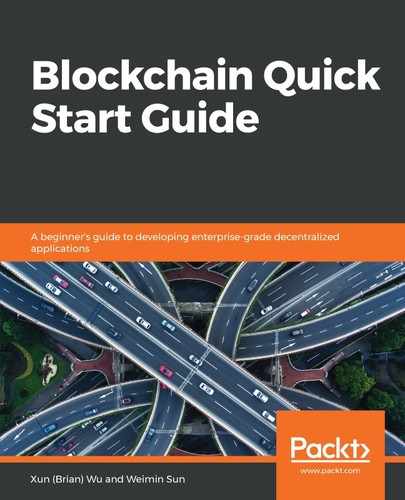Chapter 1, Introduction to Blockchain Technology, gives an overview of blockchain and its key concepts, such as cryptography and hash algorithms, the distributed ledger, transactions, blocks, proof of work, mining, and consensus. We cover Bitcoin, the mother of blockchain technology, in detail. We briefly introduce Ethereum by pointing out some limitations of Bitcoin and how they are addressed by Ethereum. While Bitcoin and Ethereum are examples of public blockchains, IBM's Hyperledger is used as an example of enterprise blockchains. Toward the end of this chapter, we look at the evolution of blockchain, through 1.0, 2.0, 3.0, and beyond, and we examine their use cases.
Chapter 2, Ethereum Fundamentals, covers the basic concepts of Ethereum, such as smart contracts, ether, consensus algorithms, EVM, gas, and accounts. We will discuss Ethereum performance and review ideas on how to improve the overall performance via proof of work, casper, plasma, and sharding.
Chapter 3, Overview of Solidity Programming, discusses what solidity is, as well as the tools for the solidity development environment. We then discuss smart contracts and their common patterns. We cover the important topic of smart contract security. Finally, we show how to write a smart contract with a use case of crowdfunding.
Chapter 4, Building an Ethereum Blockchain Application, looks at what a DApp is. We give a quick overview of web3.js. We explain how to set up an Ethereum development environment, as well as how to develop and test a DApp.
Chapter 5, Exploring an Enterprise Blockchain Application Using Hyperledger Fabric, gets into the key concepts of Hyperledger Fabric, along with the core components. We explain how to create a Hyperledger Fabric environment, how to write a chaincode, and how to set up Hyperledger Fabric configuration.
Chapter 6, Implementing a Business Network Using Hyperledger Composer, provides an overview of Hyperledger Composer and talks about how to set up a Hyperledger Composer environment. We discuss business scenarios, the business network archive, and how to implement a business transaction function.
Chapter 7, Blockchain Use Cases, first talks about popular blockchain use cases across industries, including the financial sector, civil services, supply chains, the Internet of Things (IoT), and healthcare, at a high level. We will then proceed to a discussion of the proper use cases for DApps, before then developing a successful DApp. Finally, we take the health data-sharing use case and comment at a high level on building an DApp for it.
